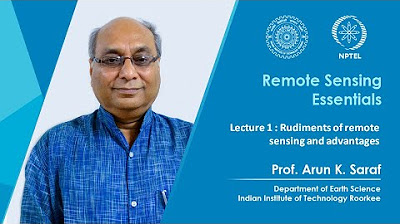PENGINDERAAN JAUH
Summary
TLDRThis video delves into the concept of remote sensing, a pivotal technology in modern society, with applications like Google Maps. It outlines remote sensing as the science and art of acquiring information about objects or phenomena on Earth without direct contact. The system comprises components like energy sources, the atmosphere, sensors, object interaction, data acquisition, and data users. The video explains the roles of active and passive energy sources, the atmospheric window, sensor types, and the importance of data interpretation by users in analyzing Earth's surface features.
Takeaways
- 🌍 Remote sensing is a technique developed to acquire and analyze information about Earth.
- 🛰️ Remote sensing uses sensors to collect data without direct contact with objects.
- 📡 Remote sensing systems consist of several components that work together, such as energy sources, sensors, atmosphere, and data acquisition.
- 🌞 There are two types of energy sources in remote sensing: active (artificial sources like lamps) and passive (natural sources like sunlight).
- ☁️ The atmosphere plays a crucial role in transmitting electromagnetic waves, influencing which waves reach the Earth's surface.
- 📷 Sensors in remote sensing can be either photographic (capturing photos) or electronic (capturing electrical signals to create digital data).
- 💡 Objects on Earth reflect or absorb energy differently, which affects how they appear in remote sensing images.
- 🌊 Water bodies tend to appear darker in remote sensing images due to their high absorption of light, while buildings reflect more light and appear brighter.
- 🖼️ Data from remote sensing can be obtained as manual (interpreted by human analysts) or digital (processed using software).
- 👤 The success of remote sensing depends on the user’s ability to accurately interpret the data, requiring knowledge and expertise.
Q & A
What is remote sensing, according to David Telin Grand?
-According to David Telin Grand, remote sensing refers to various techniques developed to acquire and analyze information about the Earth.
How do Lillesand and Kiefer define remote sensing?
-Lillesand and Kiefer define remote sensing as the science and art of obtaining information about an object, area, or phenomenon through the analysis of data acquired without direct contact with the object.
What is the general definition of remote sensing based on expert opinions?
-Remote sensing is defined as the science, art, and technique of recording objects, phenomena, and areas on the Earth's surface from a distance without direct contact with the object.
What are the main components of a remote sensing system?
-The main components of a remote sensing system include energy source, atmosphere, interaction with objects, sensors, data acquisition, and data users.
What is the role of energy sources in remote sensing?
-Energy sources provide the necessary illumination for capturing images. In remote sensing, there are active sources (artificial light, such as lamps) and passive sources (natural sunlight).
How does the atmosphere affect remote sensing?
-The atmosphere influences how electromagnetic waves are transmitted, absorbed, or scattered before they reach objects. It selectively allows certain wavelengths through, which is referred to as the 'atmospheric window.'
What are the two types of sensors used in remote sensing?
-There are two types of sensors: photographic sensors, which capture images using chemical processes, and electronic sensors, which record data in electronic form for further processing.
How do objects on the Earth's surface interact with energy in remote sensing?
-Objects reflect or absorb energy differently based on their characteristics. For example, water and vegetation tend to reflect less energy and appear darker in imagery, while buildings reflect more and appear brighter.
What are the two main types of data acquired in remote sensing?
-Remote sensing data can be manual, obtained through image interpretation using tools like stereoscopes, or digital, obtained through specialized software and processed into visual or numerical data.
Why is the role of data users important in remote sensing?
-Data users play a crucial role in the success of remote sensing by interpreting the images. The accuracy of the analysis depends on the user’s knowledge, experience, and understanding of the data.
Outlines

Dieser Bereich ist nur für Premium-Benutzer verfügbar. Bitte führen Sie ein Upgrade durch, um auf diesen Abschnitt zuzugreifen.
Upgrade durchführenMindmap

Dieser Bereich ist nur für Premium-Benutzer verfügbar. Bitte führen Sie ein Upgrade durch, um auf diesen Abschnitt zuzugreifen.
Upgrade durchführenKeywords

Dieser Bereich ist nur für Premium-Benutzer verfügbar. Bitte führen Sie ein Upgrade durch, um auf diesen Abschnitt zuzugreifen.
Upgrade durchführenHighlights

Dieser Bereich ist nur für Premium-Benutzer verfügbar. Bitte führen Sie ein Upgrade durch, um auf diesen Abschnitt zuzugreifen.
Upgrade durchführenTranscripts

Dieser Bereich ist nur für Premium-Benutzer verfügbar. Bitte führen Sie ein Upgrade durch, um auf diesen Abschnitt zuzugreifen.
Upgrade durchführenWeitere ähnliche Videos ansehen

Penginderaan Jauh: Pengertian dan Komponen | Geografi Kelas 10 - KHATULISTIWA MENGAJAR

Penginderaan Jauh: Pertemuan 1

Lecture 1 : Rudiments of Remote Sensing and Advantages

Geografi Kelas X "Interpretasi Citra Penginderaan Jauh" bersama Ustazah Della Vinta Asprilla, S.Pd.

Definisi dan Komponen Penginderaan Jauh (PJ)/ Geografi Kelas X/ Kurikulum Merdeka

GEO 1 4 FIN
5.0 / 5 (0 votes)
